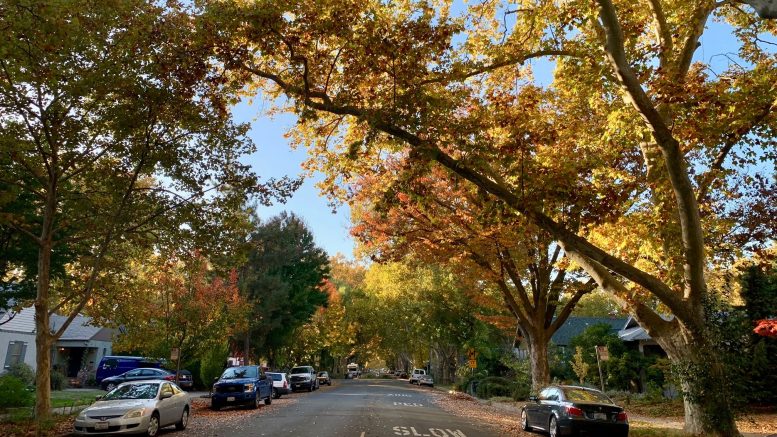California cities have the least urban tree canopy in the U.S. A Los Angeles housing project shows how residents can transform their environment — if they can get support.
By George B. Sánchez-Tello, Capital & Main
This story is produced by the award-winning journalism nonprofit Capital & Main and co-published here with permission.
Ramona Gardens is a public housing complex of more than 100 two-story buildings with more than 600 apartments next to the constant roar, buzz and exhaust of Interstate 10. Residents of Ramona Gardens were naturally concerned about the freeway’s impact, so the advocacy group they founded, Legacy LA, produced a study estimating that 218,000 cars and trucks drive by daily, spewing toxic pollution into the air that can cause asthma and cardiovascular disease as well as impair lung development. With no air conditioning in the units, apartment windows are often open. A robust grove of trees and plants could help offset the effects of that pollution, the study concluded, validating what residents long believed.
At one end of Ramona Gardens, the group North East Trees is planting nearly 400 trees. Legacy LA is also developing plans, seeded by an almost $1 million federal grant, to turn a large vacant swath into a park with 250 trees and 15,000 plants. The leaves, branches and stems of plants and trees provide cover — called “tree canopy” — that lowers heat and improves air quality. Alyza Gonzalez, leadership program coordinator with Legacy LA, said trees clean the air and create attractive spaces that inspire the community to gather outside and tend to the land. “The trees not only improve the air quality, but the quality of life here,” she said.
The actions of the Ramona Gardens residents show how a community, even one without a lot of money, is capable of deciding what they need to improve their health. It is up to those with money and power to hear them and plant those trees.
Nationwide, the amount of urban tree canopy reflects the wealth and race of an area’s residents — communities of color and low-income neighborhoods suffer from less tree cover and shade. In California, where cities were built over dry, shrubby terrain, per capita urban tree canopy is the lowest in the 50 states.
Urban tree canopy can absorb pollution primarily in two ways. Leaves can directly absorb harmful gases like sulfur dioxide, nitrogen dioxide and carbon monoxide. Trees can capture particulate matter — chemicals, dust, soot and metal particles less than a human hair’s width — from cars, trucks and factories. Fine particulates stick to leaves and stems.
Eight years ago, Ramona Gardens youth placed air quality monitors in the neighborhood.
They found the air quality to be unhealthy for more than four months out of the year. The teenagers began working with North East Trees to plant and tend to trees around their apartments. Today, when walking through Ramona Gardens, it’s common for a young person to point out a tree they planted, exuding a certain pride, Gonzalez said. It’s also common for those kids to be sick.
Among the 50 Youth Council members, most suffer asthma, which has caused them to miss meetings and classes because of flare-ups. Asthma is a common chronic illness in Ramona Gardens, said Gonzalez — so common it’s a regular joke among the kids. Around this time of year, those youth are more susceptible to bronchitis if they catch the flu.
Ramona Gardens youth know their illness is affected by urban policies. “It dawned on them when they realized the disinvestment in Ramona Gardens,” Gonzalez said of the Youth Council. “They’ve done nothing to deserve chronic health conditions and the disinvestment in their community.”
Tanushree Biswas, who has studied California’s urban tree canopy for the Nature Conservancy, said it is possible to reverse those decades of disinvestment. There is space in urban areas statewide to plant 36 million additional trees. Planting and maintaining those trees would cost about $19 per tree annually, she said.
It will take a commitment from city, county, state and federal officials to get that money.
Biswas’ research team has structured their research to serve as a guide for both community members and decision makers in government or philanthropy. They use only open-source data that residents of communities like Ramona Gardens can look up themselves, and laid out which areas most need tree cover to lower temperatures and air pollution. “All these datasets are providing pathways for lawmakers to seek solutions at a statewide level to bring investments to cities,” Biswas said.
Biswas’ words echo a sentiment I heard from Aaron Thomas of North East Trees, Alyza Gonzalez and the residents of Ramona Gardens I spoke with. When it comes to health, and the value of trees, people here understand what they need and where those resources need to go. It is up to funders, both public and private, to step forward.
Copyright 2023 Capital & Main


Be the first to comment on "Without tree cover, urban Californians are hit harder by heat, air pollution"